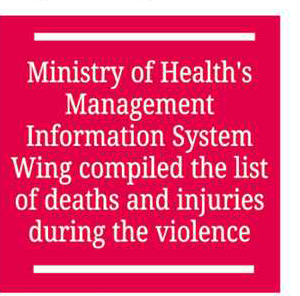
631 killed, 19,000 injured during student-led mass uprising
Tuesday, 10 September 2024
At least 631 people have been killed and 19,200 injured during the protests calling for reforms to the quota system for government jobs, which eventually became an anti-government movement that toppled the Awami League from power, reports bdnews24.com.
The figures account for the casualties from Jul 15 to Aug 5 as the violence surrounding the Anti-Discrimination Student Movement intensified, according to a report by the Ministry of Health.
The Ministry of Health's Management Information System Wing compiled the list of deaths and injuries during the violence. The information was compiled using information from public and private hospitals across the country. The list will be regularly updated.
The report says that at least 450 people were brought to the hospitals already dead, while another 181 died while receiving treatment.
The quota reform protests intensified after Jul 15. On Jul 16, Begum Rokeya University student Abu Sayed died after being shot by police. Five others were killed across the country that day.
As the protests escalated, so did the violence surrounding them. Finally, on Aug 5, in the face of a student-led mass movement, Sheikh Hasina resigned her premiership and fled to India.
On Aug 15, the Ministry of Health formed a committee to list all those who were injured or killed during the protests. Mohammad Humayun Kabir, former senior secretary of the Health Services Division, was named the head of the committee.
The MIS system is compiling the information based on the committee's supervision. The committee submitted the report to the ministry on Thursday.
Citing the report, Kabir said on Monday that more than 16,000 of those injured sought treatment at public hospitals, while at least 3,000 others sought treatment at private hospitals.
The current numbers are only preliminary data and will be updated regularly, he said.
Most of the deaths - 477 - were in the Dhaka Division, according to the information Kabir provided. Another 43 people died in the Chattogram Division, 39 in the Khulna Division, and one in the Barishal Division.
Dhaka was also ahead on the injury count, which stood at 11,000 in the division. Approximately 2,000 people were injured in the Chattogram Division.

Of those who sought treatment at hospitals, 3,048 were seriously injured and required surgeries. At least 535 are permanently disabled due to their injuries.
The committee began work on Jul 18 and will continue its work.
"Our sources were hospitals. We also gathered information outside of them, but after verifying it through certain processes. We have also given some guidelines on what the policy should be."
Fewer victims may have been brought to the hospitals at the start of the movement due to various reasons, including fear of litigation, Kabir said. As a result, the total number of the dead may increase.
"Many of the dead were not brought to the hospitals. At the end of July and the beginning of August, many could not come to the hospital as there were certain situations, including lawsuits. So I think the death toll will increase as those not in the system will be added. But we feel that the number of injured will not increase much."
Asked whether government employees or police are among the list of the dead, Kabir said that the list should include students and members of the public, but could not confirm it.
"We haven't verified every list, so we can't say. If the hospitals have given the names of police in the death toll, then perhaps they are included. Government employees are not supposed to be on the list. It is the government's decision who they will declare as martyrs.
But I think there should be a separate list for the police. Because if there are members of the government on this list and they died while trying to attack others, it should be looked into."